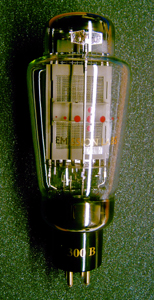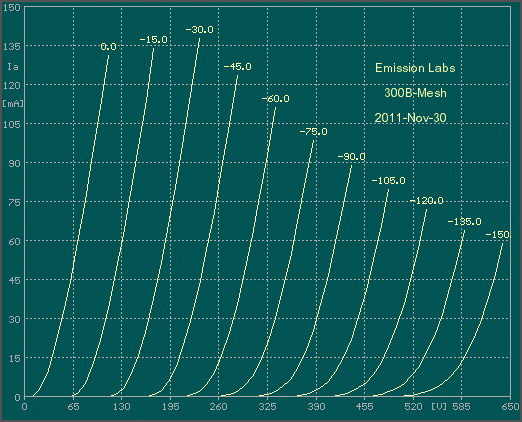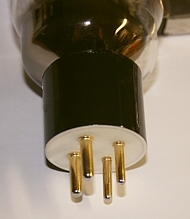EML 300BM Data Sheet
long Anode version
Description
 |
The 300BM can replace a standard 300B in some cases, but not in all cases. So please read this data sheet carefully. It is not always possible, simply plug & play a 300BM into a 300B amplifier. If not checked with care, overheated anodes may result, and such a damage is not covered by the guarantee. |
The 300BM can replace a normal 300B tube, if the following conditions are met:
- Bias and Anode dissipation must be reduced to typical 22 Watt, or to absolute maximum of 28 Watt. (see below table)
- Filament current of minimum 1.4 Ampere must able to supply by the amplifier. This is very important. Otherwise, heater voltage will drop below 5V, and the tubes may fail.
- The larger length of the tube glass is no problem. (like with closed amplifiers).
This is a 'long Anode' version,. The Anodes are 25% longer as with normal 300B. The physical size of this tube, inside and outside is the same as the larger 300B-XLS tubes we make, so it is larger than you may expect from a 300B. Check the dimensions at the end of this Data sheet.
The heat dissipation of the wire mesh is lower than for Solid Plate anodes. So the maximum Anode dissipation of the 300BM for continuous use must be limited to typical 22Watt, or absolutely maximum 28Watt. This is however a classical use condition in some Japanese amplifers. However most amplifiers exceed this number, so it is important to check with your amplifier manufacturer first, if you are not sure about the Anode dissipation.
Guarantee program for first owner.
The first owner can register the tube within 4 weeks after receival, at the Emission Labs website, to participate in the 5 years guarantee program, which is additional to the legal obligations of the seller.
Register here for the 5years guarantee
Features
- Gray Wire Mesh Anodes, mounted on a hard metal frame for best stability.
- Gold Plated, Wolfram Grid
- Soft rubber suspended tube base
- Cathode Tapped filament
- Slow Start filaments, for best lifetime
- Hard metal Construction (Notes)
- Extra large getters
- Hand blown Glass bulb
- Anti-microphonic Anode- and grid suspension
- These tubes are shipped in a high quality dual box
- Tube printing with real gold and red color is glass burned into the glass
- Gold Plated pins, black ceramic socket White bottom
Sound Character of the EML 300BM tube
Why Mesh Anodes? When a tube is given mesh Anodes, something magic happens to the sound. We believe this is caused by the better damping properties of the wire mesh material. A Solid Plate anode due to it's circular construction will have quite some ringing (bell like effect). A mesh anode will not have this effect. In most cases, when using mesh tubes, you will experience a more transparent sound stage, meaning a more realistic stereo reproduction of the original sound recording. With mesh tubes you will enjoy the very best of what small triodes have to offer.
Note: mesh means woven metal wire. Chinese factories make a tube with punched Anodes, and thin metal, and for marketing purposes call this 'mesh'. Which is not so. Such a punched Anode from thin metal, will have a ringing effect, with metallic sound, and will not have the superior resonance damping properties, a wire mesh anode has.
EML 300BM Filament Ratings |
|
Filament Voltage Important: See notes at page bottom |
= 5 Volt (AC or DC) |
| Tolerance on filament voltage | 4% |
| Filament Current | ~ 1.4 Ampere |
.
300BM Maximum Conditions
|
|
| Anode Voltage | |
| Anode Current | |
| Peak Anode Dissipation | |
Grid resistor @ Anode Dissipation= 22 Watt |
|
| Grid resistor @ Anode Dissipation= 24 Watt | |
| Grid resistor @ Anode Dissipation= 26 Watt | |
| Grid resistor @ Anode Dissipation= 28 Watt | |
.
300BM Recommended Single Ended operating points | |||||||
Anode Voltage
| Control Grid Voltage |
Anode Current (ma) |
Anode Rp (Ohm) |
Load (Ohm) |
Anode Dissipation (Watt) |
Power Output (Watt) |
2nd harm. (dB) |
350 |
-73 |
63 |
720 |
2000 |
22 |
10.6 |
21 |
350 |
-73 |
63 |
720 |
3000 |
22 |
8.7 |
26 |
350 |
-73 |
63 |
720 |
4000 |
22 |
7.3 |
30 |
350 |
-72 |
70 |
685 |
3000 |
24 |
8.5 |
28 |
. |
|||||||
400 |
-74 |
60 |
720 |
3500 |
24 |
10.5 |
26 |
. |
|||||||
440 |
-101 |
59 |
775 |
4000 |
26 |
12 |
26 |
440 |
-101 |
59 |
775 |
5500 |
26 |
9.6 |
30 |
* For best lifetime, it is recommended to choose maximum 26 Watt Anode dissipation, though 28 Watt is possible at some compromise with life time. If you need higher output power than 300BM can do, choose standard 300B tube, or upgrade to 300B-XLS. Choice of output transformer impedance: For each working point, a wide range of primary impedance is possible. When using a transformer of another value, you can estimate the output power and distortion by averaging between two rows of this table. Example: 450V, 60mA. Use of Lundahl LL1679-70mA (4k5 type). This will give you appr. 11.5 Watt @ 27dB 2nd harmonics. (28dB distance of signal to 2nd harmonics. |
|||||||
.
EML 300BM Factory Test conditions |
|
| Anode Voltage | |
| Anode Dissipation | |
| Anode Current | |
| Control Grid Voltage | |
| Anode Impedance | |
| Amplification Factor | |
| Transconductance | |
| Control Grid Voltage | |
| Transconductance | |
.

EML 300BM tube curves. See Notes
300BM Anode Curves Print Version (full size pdf)
![]()
Download these curves as PTE file
Some recommended Lundahl transformers for the 300BM |
|||||
Primary |
Secondary |
Auto Bias Cathode resistor |
Anode Current |
Anode Voltage to ground |
|
| LL1623-090mA 11Hz @1.5dB |
3000Ω |
Alt.B = 4Ω Alt.C = 8Ω Alt.D = 16Ω |
750 Ohms |
80mA |
435V |
LL1664-080mA |
3000Ω |
8Ω |
750 Ohms |
80mA |
435V |
EML 300BM Mechanical Data |
|
UX4 Base |
Size including Socket 175 x 63 mm Pin 1: Heater1 Weight of one tube: Shipment weight for pair in gift box: |
Notes
- Hard-metals can be used in electron tubes, though these are more difficult to use, and more costly than classic nickel. Hard metal Anodes have a more precise Anode distance, and do not change shape when heated, or at mechanical shock. This ensures reproducible tube parameters, and long term stability. Wolfram grids allow the most precise grid wire distance, because wolfram is an extreme hard metal. Best grid geometry ensures uniformity and linearity of the tube curves.
- Individual Test data, such as: Matching Data, Grid Current, Vacuum, Filament Current, etc., are on the Certificate that is on the outside of the tube box. Each tube is numbered from the inside, with a metal Tag
- Do not experiment with lower filament voltage, to expect better lifetime. We already specify filament voltage for the best lifetime.
- Gold Plated grids have a few advantages, such as increased bias stability, some protection against accidental overload, and better linearity of tube curves.
- Heater voltage is always defined at the tubes pins itself. There may be some voltage drop along the wires, and tube contacts as well. So voltage measured at the tube socket wiring should ideally be 5.1V.

